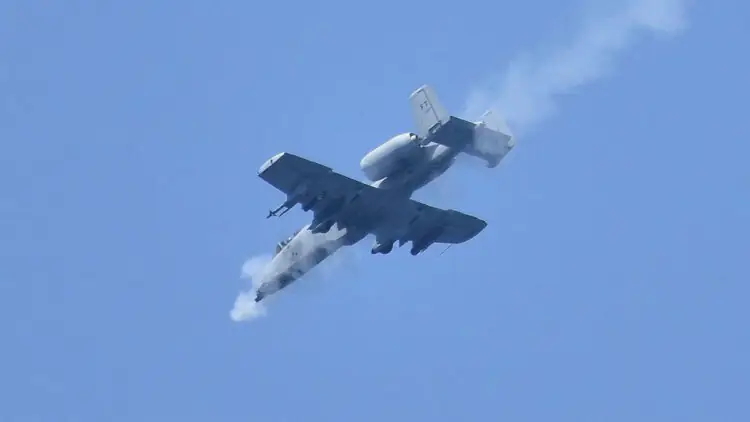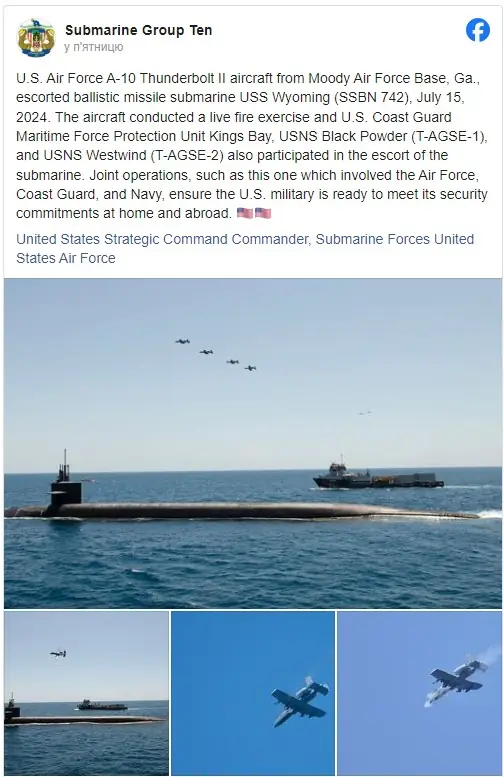A squadron of A-10 Thunderbolt II close air support aircraft was once again deployed to escort the Ohio-class ballistic missile submarine Ohio USS Wyoming (SSBN 742). Photos shared on social media by Submarine Group Ten show the Wyoming and its escort moving in an undisclosed location in the U.S., with six A-10Cs flying overhead.

The aircraft assigned to Moody Air Force Base escorted the submarine and also participated in combat training with the 30mm GAU-8 cannon and 70mm rockets. The escort for the submarine included the U.S. Coast Guard Maritime Security Unit Kings Bay, the U.S. Navy destroyer Black Powder (T-AGSE-1), and the U.S. Navy destroyer Westwind (T-AGSE-2).
This rare occurrence is not unprecedented, as earlier this year, the U.S. Navy submarine Nebraska was also escorted by a quartet of A-10 Warthogs during its transit through the San Juan de Fuca Strait. However, in that instance, the A-10s did not engage in combat training and flew without external ordnance. “Joint operations like this, involving the Air Force, Coast Guard, and Navy, ensure the readiness of U.S. armed forces to fulfill their security commitments both domestically and abroad,” stated both branches. The services did not provide further details on the scale of these joint operations.
TABLE OF CONTENT:
A-10 Thunderbolt II and the maritime zone
Although no additional details have been released, it appears that the Warthogs were conducting surveillance of an extremely valuable strategic asset during one of its most vulnerable phases of navigation. Training with live fire might have also been used to simulate the protection of the USS Wyoming destroyer against surface threats. In previous exercises, A-10s were used to target groups of small boats and strike smaller military vessels, highlighting the attention these types of asymmetric threats have garnered following recent real-world events such as attacks in the Red and Black Seas.
The A-10, originally designed as a close air support and anti-tank platform, has never been used extensively in maritime operations, with only limited application. One of the most notable instances occurred in 2011 during Operation Unified Protector, when A-10s and P-3C Orions jointly attacked a patrol boat and several small assault ships in the port of Misrata, Libya.

Over the past two years, the Warthog has participated in numerous maritime surface warfare exercises and conducted training in unit defense. In one such exercise, in September 2023, two A-10 aircraft teamed up with the Arleigh Burke-class guided-missile destroyer USS Stethem to counter simulated surface threats in the Gulf of Oman.
The A-10’s maneuverability at low speeds and altitudes, precision weapon delivery, and extended time on station are key features that make it highly effective in providing air support to American and coalition forces on land and at sea, according to the U.S. Air Force after one such exercise last year.
Asymmetric threats to maritime assets
Events in the Black and Red Seas have once again highlighted the need to not underestimate asymmetric threats. In the past, the U.S. Navy has dealt with small, fast-attack vessels, particularly in the Persian Gulf, where Iran regularly pursued American ships in the area.
Recently, both Ukraine and the Houthis have demonstrated the effectiveness and danger posed by unmanned surface vehicles used in kamikaze attacks against large ships. Small, explosive-laden drones can leverage their limited size and high maneuverability to evade detection and interception, causing devastating damage to their targets.

Well-protected targets can be attacked by coordinated swarms of drones, challenging traditional naval strategies. The presence of multiple fast-approaching and maneuvering targets against a limited number of weapons systems on a naval vessel can confuse defenses, which must prioritize targets to maximize hit probability and avoid wasting valuable ammunition.
This is where air defense systems like the A-10C can be particularly useful, as they provide naval command with a range of capabilities for both surveillance and kinetic effects.
Source: theaviationist











A-10 Thunderbolt II – a legend!
A-10 Thunderbolt II – a legend!